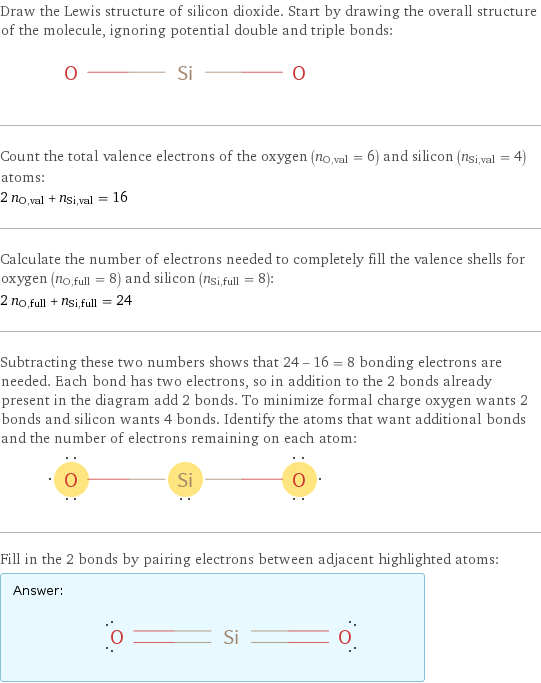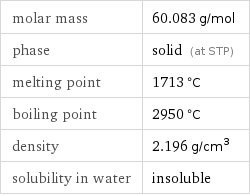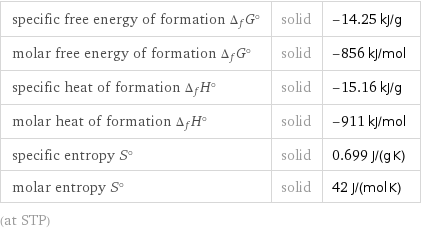Input interpretation

silicon dioxide
Chemical names and formulas

formula | SiO_2 Hill formula | O_2Si name | silicon dioxide IUPAC name | dioxosilane alternate names | amorphous silica | diketosilane | dioxosilane | silica | silicon dioxide amorphous | silicon(IV) oxide | vitreous silicon dioxide mass fractions | O (oxygen) 53.3% | Si (silicon) 46.7%
Lewis structure

Draw the Lewis structure of silicon dioxide. Start by drawing the overall structure of the molecule, ignoring potential double and triple bonds: Count the total valence electrons of the oxygen (n_O, val = 6) and silicon (n_Si, val = 4) atoms: 2 n_O, val + n_Si, val = 16 Calculate the number of electrons needed to completely fill the valence shells for oxygen (n_O, full = 8) and silicon (n_Si, full = 8): 2 n_O, full + n_Si, full = 24 Subtracting these two numbers shows that 24 - 16 = 8 bonding electrons are needed. Each bond has two electrons, so in addition to the 2 bonds already present in the diagram add 2 bonds. To minimize formal charge oxygen wants 2 bonds and silicon wants 4 bonds. Identify the atoms that want additional bonds and the number of electrons remaining on each atom: Fill in the 2 bonds by pairing electrons between adjacent highlighted atoms: Answer: | |
Basic properties

molar mass | 60.083 g/mol phase | solid (at STP) melting point | 1713 °C boiling point | 2950 °C density | 2.196 g/cm^3 solubility in water | insoluble
Units

Solid properties (at STP)

density | 2.196 g/cm^3 refractive index | 1.544
Units

Thermodynamic properties

specific free energy of formation Δ_fG° | solid | -14.25 kJ/g molar free energy of formation Δ_fG° | solid | -856 kJ/mol specific heat of formation Δ_fH° | solid | -15.16 kJ/g molar heat of formation Δ_fH° | solid | -911 kJ/mol specific entropy S° | solid | 0.699 J/(g K) molar entropy S° | solid | 42 J/(mol K) (at STP)
Chemical identifiers
![CAS number | 60676-86-0 SMILES identifier | O=[Si]=O RTECS number | VV7328000 MDL number | MFCD00011232](../image_source/af537011e278cc2dce1d8f0607fd5295.png)
CAS number | 60676-86-0 SMILES identifier | O=[Si]=O RTECS number | VV7328000 MDL number | MFCD00011232
Toxicity properties

odor | odorless lethal dosage | 3160 mg/kg (oral dose for rats)

probable lethal dose for man | 600 mL (milliliters)